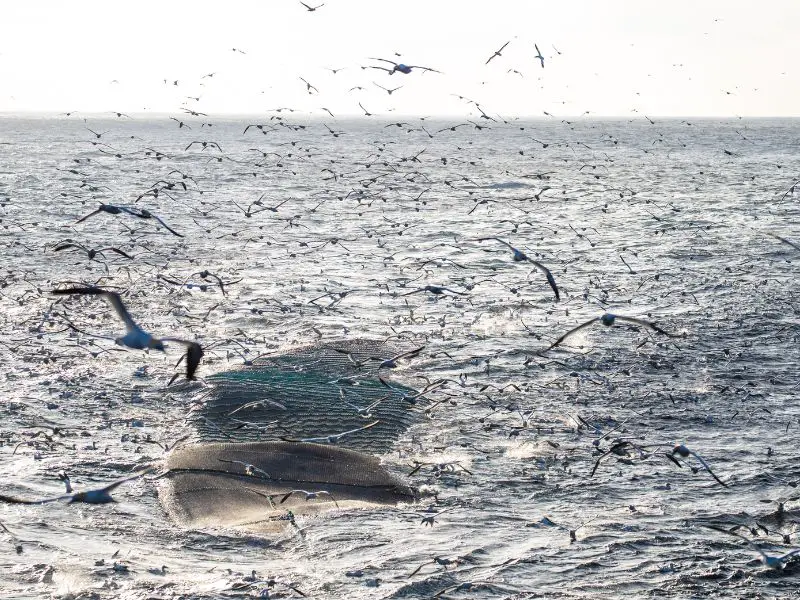Trawl fishing or bottom trawling is a fishing technique whereby a fishing vessel drags a trawl net along the sea floor. This fishing technique has been used for hundreds of years and is still widely practiced today. Trawling fishing requires a skilled crew and an efficient fishing vessel to catch fish, and it can be dangerous if the trawling net snags on an underwater structure such as a reef or wreck.
Researchers and environmentalists often cite bottom trawling as one of the most harmful fishing methods. Everything in its paths, such as fish, crustaceans, coral reefs, and seagrass meadows, is caught in the massive nets. Wherever trawlers operate, the ocean bottom becomes a barren wasteland. In this article, we look at what’s bottom trawl fishing and its impact on the environment.
What Is Bottom Trawl Fishing?
Bottom trawling is a mode of fishing in which they dragged massive nets around the seafloor, capturing everything in their path. It destroys the benthic layer, the crucial uppermost layer of the seabed, and catches not originally targeted young fish and species.
They often return this bycatch to the ocean, although most of it does not survive. To not overfish, fish regulations are in place to discard fish perfectly suitable for human consumption.

What’s the Problem With Trawl Fishing?
The environmental effects of trawling make the practice problematic. Bottom trawling, where heavy fishing gear is dragged over the seafloor, is a major cause of coral bleaching, habitat degradation, and seaweed depletion.
Does Fish Trawling Entail Overfishing?
Bottom trawling is an effective method for catching a lot of fish since trawl nets are often quite huge, and trawlers can drag these nets across extensive distances. The scale of these activities may quickly deplete fish populations, and overfishing can ultimately result in the extinction of fish species.

Trawling is a kind of fishing in which large weighted nets are dragged down the ocean floor to collect fish. This form of fishing is known as “bottom trawling.” Some commercial fishing operations prefer this technique because it captures significant numbers of fish in a single operation.
What’s the Effect of Trawling on Climate Change?
Accounting for carbon emissions in the fishing industry is a new area of research. While studies claiming that bottom trawling emissions are equal to the aviation industry are debatable, there is little question that some bottom-trawled species are the most fuel-intensive kinds of animal food in the world (more than chicken and lamb).
According to research, China, Vietnam, and Indonesia are the three largest producers of trawled fish in terms of volume. The top 20 countries include the United States, the United Kingdom, Russia, Norway, and New Zealand. West African states lead in terms of intensity (the quantity of trawled catch per size of the country’s marine area); yet, up to 90% of this is captured by foreign nations fishing in those countries’ internal seas – via trade treaties that are often unjust.
What Are the Steps to Be Taken to Stop Trawl Fishing?
The good news is that governments can end bottom trawling and its harmful repercussions. For countries with vast national seas where bottom trawling occurs, protecting only 4% of their waters might remove 90% of the danger of carbon disruption.
On the other hand, efforts to reduce the harmful impacts of bottom trawling have centered on enhancing fisheries management or implementing different restrictions. In specific locations, the carbon footprint of the trawl fishing industry has stabilized or even decreased due to technological advancements that have reduced the intensity of seafloor contact.

Restrictions have varied from highly controversial prohibitions (such as in Indonesia and Costa Rica) to gradual, adequately-funded transitions (e.g., Hong Kong, Belize). Regardless of the technique, leaders can address the ongoing, intractable dispute over the future of bottom trawling by supporting fair, productive, and comprehensive approaches.
Some segments of the fishing industry, academics, governments, civil society, and non-governmental organizations are surprisingly in agreement that bottom trawling poses unique and significant obstacles to fisheries’ environmental, social, and climatic objectives.
Suppose all parties manage to work together more constructively. In that case, we may advance toward a more sustainable future in which the rights of individuals working in the sector and the ecosystems get fair and sustainable treatment.
Bottom Line
Trawl fishing is an environmental risk that we are all facing. Due to the massive bycatch generated in bottom trawling, some species will likely become extinct shortly. The impacts of trawling on marine ecosystems are immense. Reefs, seagrass beds, and kelp forests are also at risk from trawling. Trawling also jeopardizes the future food security of coastal communities and could contribute to food insecurity on a global scale.
With greater political attention to the risks posed by trawl fishing, we can significantly decrease the negative impacts of this activity on marine life and marine ecosystems. Thus, we can prevent the global collapse of marine species diversity and protect coastal communities from the effects of trawl fishing.
Related: Is It Illegal to Collect Rainwater, 10 Simple Ways to Conserve Water and Save Money, Organizations Fighting Ocean Pollution


1 thought on “Protecting Coastal Communities From the Threat of Trawl Fishing”